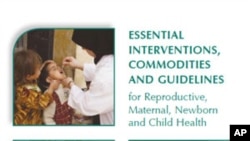A new three-year study has come up with a global consensus on how to reduce the number of women who die during pregnancy and child birth. The recommendations are also expected to help lower the number of children who die before age 5. It’s estimated nearly 360,000 women die each year during pregnancy and childbirth and 7.6 million children die before age five.
The study has been released by the World Health Organization, the Aga Khan University and the Partnership for Maternal, Newborn and Child Health.
It’s different
“What is different is that we have pulled together all of the data for interventions across the continuum of care, from pre-pregnancy, through pregnancy, through childbirth, through early post-natal period for mother and for baby and for the child,” said Dr. Elizabeth Mason, director of the WHO’s department of Maternal, Newborn, Child and Adolescent Health.
Previous studies had a much more narrow focus, concentrating on a specific period. The new study is entitled Essential Interventions, Commodities and Guidelines for Reproductive, Maternal, Newborn and Child Health.
“It all comes in one package, she said, “and it is an easy reference guide for policymakers, for organizations…health practitioners to be able to see what are the critical interventions right across the continuum of care.”
Interventions
There are 56 essential interventions for maternal and child health. For example, Mason said, “In the pre-pregnancy period, one is family planning, but a second key is folic acid, which has been demonstrated to reduce or prevent, rather, neural tube defects. That’s spinabifida and these types of defects,” she said.
Other interventions include prevention and management of post-partum hemorrhaging, prevention of mother-to-children transmission of HIV, use of anti-hypertensive drugs to reduce blood pressure, greater use of Cesarean section, immediate thermal care for newborns and treating children for pneumonia. If the recommended interventions are followed globally, Mason said she expects to see “a significant reduction in maternal mortality, reduction in stillbirths, a reduction in newborn mortality and a reduction in child mortality.”
The study states, “A child’s greatest risk of dying is during the first 28 days of life, accounting for 40 percent of all deaths among children under the age of 5” half of those deaths occur within the first 24 hours after being born.
Mason said countries already using these interventions and others have seen improvement. “The aim is that the countries that are currently not – many of the low and middle income countries – if they did this, then they would achieve the Millennium Development Goals 4 and 5,” she said. Goal 4 concerns child mortality and goal 5 relates to maternal health.







